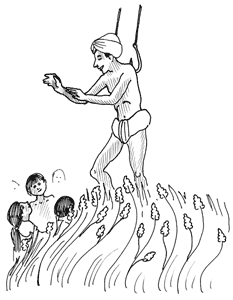STRANGE BUT TRUE- Left hanging: Hooks attached en route

Q. Rate the pain you might feel if somebody stuck two 10-inch steel hooks through the meat of your back, in under the muscles, then attached ropes and lifted you to hang in midair? a) excruciating b) you'd pass out c) no big deal. –L. Prince
A. The answer is "c" if you're a "celebrant" undergoing the ceremony of hook-swinging, done in parts of India to bless the children and crops, says psychologist Ronald Melzack in The Puzzle of Pain. Astonishingly, the hook-swinger shows little discomfort while being transported from village to village, holding onto the suspension ropes with his hands to lessen the flesh tear, but at climactic moments letting go. Now he seems in a state of exaltation!
How such pain can be blocked out is a mystery, but one theory holds that the mind sends out signals to interrupt a "gate" in the spinal cord. Some people can do this and some can't, depending on the culture and circumstances.
"When the hooks are later removed, the wounds heal rapidly without any medical treatment other than the application of wood ash. Two weeks later, the marks on his back are scarcely visible."
Q. Are days and nights always of equal length at the equator, or do they vary through the year as in the Northern and Southern hemispheres? – F. Magellan
A. They're never of equal length right at the equator. In fact, the period from sunrise to sunset is always several minutes longer than the night for two reasons, reports the U.S. Naval Observatory:
(1) Sunrise is defined as the instant when the sun's leading edge becomes visible on the horizon, sunset when the trailing edge disappears, which include times when the Sun's center is already below the horizon.
(2) Atmospheric refraction bends the sun's light up over the horizon, making sunrise/sunset appear earlier/later by a few minutes. At higher latitudes in the Northern hemisphere, the date of equal day and night occurs before the March equinox and after the September equinox, varying with location. (In the Southern hemisphere, it's before the September equinox and after the March one.)
"On the dates of the equinoxes, the day is about 7 minutes longer than the night at latitudes up to about 25 degrees, increasing to 10 minutes or more at latitude 50 degrees," says the Observatory. For a weird one, take a trip to the North Pole, says National Geographic News. Here at vernal equinox you'll see the sun skimming across the horizon, beginning six months of daylight. (It's the reverse at the South Pole.)
Q. In the all-too-booming marketplace for nuclear weapons, what are the best "bargains" out there? –G. Bush
A. Best buy is via the highly enriched uranium (HEU) route, using centrifuge technology, which Iran is trying to perfect at the moment, says Stanford University economist Geoffrey Rothwell. Once the uranium is enriched, the cheapest nuclear weapons design is a "cannon" type, where one end of the cannon is plugged with about 15 kilos of HEU, the other end is packed with a 15kg HEU "cannon ball" plus chemical explosives.
When the chemicals explode, the two pieces of HEU are driven together and attain a critical mass, triggering a chain reaction, and big bang. The geometry of all this is complicated, and the whole package weighs a lot, making the delivery difficult. The cheapest delivery system is a standard container that can be easily transported by trucks, trains, planes.
"This beats the cost of a plutonium weapon, which doesn't require uranium enrichment but makes a big mess–lots of radioactive signatures, and thus hard to get away with, whatever the cost. Thermonuclear weapons, 'H-bombs,' are even more expensive and more complicated," Rothwell says. That;s the "dismal science" behind the biggest boomers.
Q. In 200 words or less, how did brainy you get here? –Dr. Ruth
A. First you were a zygote, a fertilized egg; then this single cell divided into 2 cells, then 4, 8, 16, 32, 64, 128, 256... all the way up to trillions of cells. And here's the amazing part: Virtually all of these cells are fundamentally the same, bearing your entire genetic blueprint (except for sex cells and a few others). This is what makes cloning possible.
Then at some point along the way of your development, a handful of cells got the assignment: "Go and multiply and become a brain." They had the potential to become other body parts but somehow got "switched on" to their brainness potential, said Lewis Thomas in The Medusa and the Snail.
Or maybe all other cells got "switched off" to this high- minded job. To those few cells that divided and subdivided to become your master-schemer, dreamer, creator of music or poetry, you owe a lot. (With a couple dozen words to spare.)
Send Strange questions to brothers Bill and Rich at , coauthors of "Can a Guy Get Pregnant? Scientific Answers to Everyday (and Not-So- Everyday) Questions," from Pi Press.
#